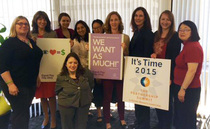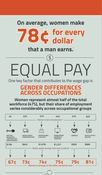 Women still earn 78 cents to the
man's dollar and women of color make even less. Equal Pay Day marks how far into the
year women must work to earn what men earned in the previous year. This year, the Women's Bureau examined one of the factors contributing to wage
inequality: gender differences across occupations.
Women's Bureau Director Latifa Lyles introduced three longtime champions in the fight for working families to
a packed house on Equal Pay Day at the department's headquarters in Washington.
House Democratic Leader Nancy Pelosi, Senior Advisor to the President Valerie
Jarrett and Rep. Rosa DeLauro of Connecticut joined Secretary Perez."When women succeed, America succeeds," proclaimed
Jarrett during her remarks. "We need equal pay now."
In Chicago, Deputy Secretary Chris Lu
participated in a roundtable discussion with tradeswomen from
Chicago Women In Trades to discuss issues women encounter gaining
entry into skilled trades. We also participated in
a lunchtime gathering in Daley Plaza with a crowd of over 150
people.
In New Brunswick, NJ the Women's Bureau Deputy Director Joan Harrigan-Farrelly served as a panelist at an event that educated college students and young alumnae from Rutgers University on the existence of the wage gap.
Roughly 30 enthusiastic Massasoit Community College students, faculty, and interested residents gathered for a Roundtable in Brockton, MA.
In Buffalo, NY Regional Administrator Grace Protos addressed the pay gap with an audience of professional women at a power breakfast and a roundtable for local employers.
|

In Philadelphia, we participated in a panel with representatives from Pathways PA, the Women’s Law Project and the Coalition of Labor Union Women. The panelists discussed policy changes in Pennsylvania including paid leave, equal pay, women’s health and eliminating occupational segregation.
We held a discussion on the gender wage gap and the laws that are in place to counteract discrimination to students and staff at University
of Texas at Dallas.
In Kansas City, we addressed more than 150 students at the University of Missouri, Kansas City about the significance of Equal Pay Day and the gap women still face. We also hosted a brown bag lunch at Kansas City Kansas Community College (KCKCC) that focused on salary negotiation.
In San Francisco, Regional Administrator Kelly Jenkins-Pultz joined advocates for a press conference that highlighted the city’s equal pay data collection ordinance, called for more action to eliminate the wage gap. We also engaged college students and faculty at San Francisco State University for a discussion about how increasing women’s participation in nontraditional jobs, sharing family responsibilities more evenly and targeting outright and inherent biases in employment can all help improve women’s wages.
In Washington state, we met with the Washington State Labor and Industries Apprenticeship Council of Joint Recruitment and Resource Committee to promote more recruitment of women in apprenticeships.
|
 -
Women account for 30 percent or less of employees in some
high-wage sectors such as computer and mathematical science and architecture
and engineering occupations. Women account for more than 70 percent of the
workforce in low-wage sectors such as personal care and healthcare support
occupations.
- Women with advanced degrees earn less than men with bachelor's degrees.
-
The impact of caregiving on the individual female
caregiver in terms of lost wages and Social Security benefits over her lifetime
equals $274,044 ($142,693 in lost wages and $131,351 in lost Social Security
benefits), as well as an estimated $50,000 in lost pension income.
|
Secretary Perez spoke at the White House Champions of Change event to honor community leaders that have done extraordinary things for working families. These champions have helped advance policies that are good for both families and businesses — such as a higher minimum wage, equal pay, paid leave, workplace flexibility and affordable quality child care.
Honored champions included Analilia Mejia, who is the Executive Director of the New Jersey Working Families Alliance — a nonpartisan organization that seeks to promote and defend the interests of New Jersey’s working families. Analilia and her team fought for New Jersey workers to be able to earn paid sick days, so they can take time off work when they are ill. President Obama remarked on the importance of their work. Click here to watch President Obama’s remarks.
President Obama has announced
an ambitious goal to double the number of apprentices by 2019. Part of
the President’s plan includes increasing apprenticeship opportunities
particularly for women and other populations that are underrepresented in
apprenticeship.
The American Apprenticeship
Grants is one of many initiatives the Department of Labor (DOL) is undertaking
to meet the President’s broader apprenticeship challenge. DOL’s
Employment & Training Administration is making available $100 million
for American Apprenticeship Grants. This is the first-ever grant of its kind, and the
grant application will close on April 30, 2015.
The Departments of
Labor and Education recently released a joint
Notice of Proposed Rulemaking (NPRM) to implement certain provisions of the
Workforce Innovation and Opportunity Act of 2014 (WIOA). The Department of
Labor also released its own
NPRM to implement certain other provisions of WIOA. Both NPRMs are now open for public review and comment.
WIOA is the result of a
bipartisan effort to reform the public workforce system. WIOA is designed
to help job seekers succeed in the labor market by providing access to
employment, education, training and support services. It is also designed
to help employers by matching them with the skilled workers they need to
compete in the global economy.
WIOA supersedes the Workforce
Investment Act of 1998 (WIA) and amends the Adult Education and Family Literacy
Act, the Wagner-Peyser Act, and the Rehabilitation Act of 1973. In
general, WIOA will take effect on July 1, 2015. DOL will issue proposed
regulations related to WIOA soon after the law takes effect. Comments must be received
on or before June 15, 2015.
|